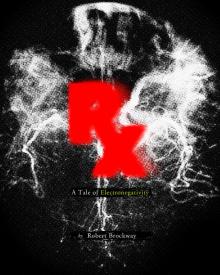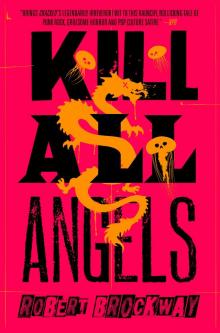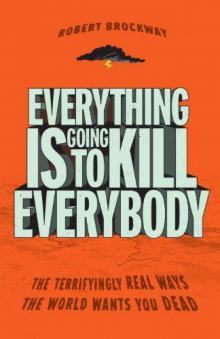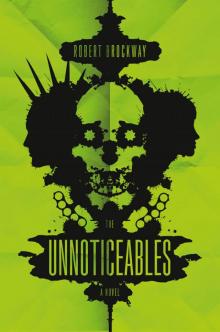- Home
- Robert Brockway
Rx: A Tale of Electronegativity
Rx: A Tale of Electronegativity Read online
Rx
A Tale of Electronegativity
By Robert Brockway
Copyright
Rx: A Tale of Electronegativity
All material within copyright © Robert Brockway, 2012. All rights reserved.
Cover design © 2012 by Meagan Brockway
Visit http://www.rxthebook.com for more information and further updates.
About the book
Rx: A Tale of Electronegativity was originally released as a three-part serial novel, containing Rx – Episode 1: The Blackouts, Rx – Episode 2: The Reservoir, and Rx – Episode 3: Industry. This edition comprises the whole story, and is a collection of all three episodes.
Dedication
This book is for my beautiful and loving wife, Meagan, who designed all of the covers and only occasionally threw bottles at me in a drunken fury. This book is for my dad, also named Robert Brockway, also loving and supporting — his only flaw being an incredibly arrogant flair for child-naming. This book is for my dogs, Detectives Martin Riggs and Roger Murtaugh, who are as wonderfully stupid as they are action-packed. And this book is for the meager handful of loyal fans who continually support me even though I abuse them so. It’s a sickness, and I sincerely hope that somebody helps them break the cycle one day. Finally, this book is for science: You keep right on making the impossible reality, you crazy-ass system of knowledge, and you let the philosophy majors worry about whether or not it’s “right.” They need something to do in-between shifts at Starbucks.
Prologue
Looking exactly downward from an impossible height, the city appears as a black diamond, bordered by a delicate line of grey. The darkness inside is riddled with flaws, crisscrossed by a series of thin, prismatic thread; a cat’s cradle of fine silver laid atop the soft, deep black of a jeweler’s felt. At each of the diamond’s vertices, the narrow leaden border expands inward, and becomes a smaller quadrilateral unto itself. Within each of those polygons is a fractal of verdant green. The color is dappled, amorphous and variegated, like a sheet thrown across a bed of gravel.
From a more modest height, the trick becomes clear. The emeralds are patches of vegetation: Hilltops, lawns and forests layered so densely above one another that they become impossible to distinguish, blurring together into a compressed motif of greens and yellows. The thin grey borders are walls, connecting the pinnacles of each of the four super-structures that support these aerial woodlands. The blurry smudge of beige surrounding it all is the Earth: Untold, indistinct miles below.
Closer still, and the ebony within the diamond resolves. It takes on depth and texture. The opaque black clarifies into smoke and ash: The tops of roiling stormclouds, caught inside the bulwarks adjoining the four buildings. The fine, chromatic threads are the flightpaths of myriad skybound conveyances, each traversing an infinite number of intersecting pathways within the storm.
Descend inside the clouds, and the air turns to caustic grease, shimmering and oily. Glowing embers, like distant campfires, sputter, gutter out, and reignite. Great segmented tubes burrow through the miasma like worms, lumbering silently from one cloudbank to the next. Mammoth containers pass seamlessly between unerring robotic arms the size of freight trains.
Below the choking ash, the vehicles become more piecemeal. Elevators, zip lines, and cable cars rumble, stall and squeak through the perpetual murk cast by the eternal storm above. Some are sleek, eggshell structures — their glossy hides whispering by in technological silence — while others are little more than metal boxes clanging, shuddering and grinding to their terminuses. Beneath them, a weave of catwalks as wide as highways, their peripheries encrusted with thousands of parasitical structures, clinging like barnacles to the hull of a ship. Pedestrians stream ceaselessly across these spans, moving in precise bursts from one building to another with the stuttering regulatory of data packets. Within the catwalks, a thousand shops, bars, and tiny homes clutter every inch of the massive hallways. From their undersides, more architectural limpets hang: Apartments slung in place by braided cables; storage units dangling from the dense webbing that spans every open expanse. Their dimly lit windows sway with each passing vehicle, like paper lanterns on a line.
Down further, and all natural light dies. The catwalks here are much like those above, though considerably more neglected: Patched up with chipboard, sheathed in tarps, and held together by a motley of wire and glue. The effect is clear: The city grows upward. Each new floor forgets, abandons and isolates those beneath it.
Lower and lower still. Here, a scattering of undulating lights. Their motion is pulsing and rhythmic. Each spot of illumination moves in turn with the next, echoing outward from the center. It is a city of piers, boats and other floating structures, all poised above an unfathomable lake of black, gently rolling with the passing of each wide, low swell. A soft static roar resonates from four gargantuan pipes at each of the cardinal directions. They run vertically, up the inner corners of each mega-structure, beginning far below the waters below, and running upward, out of sight. The Reservoir exists only to pump a constant torrent of water back up to the city, not to provide for its own people. It replenishes itself from the perpetual rain shed by Industry. It flows with the tides of filtration plants, thousands of feet below the surface of the artificial sea.
Beneath the waterline, every wall glimmers with the faint light from thousands of portholes. Though the constellation of wan yellow windows suggests that the buildings themselves are still inhabited, the disused wireframe remains of the catwalks are clearly not. Few remain even remotely intact; none are whole.
Deeper beneath the still, black water, and the massive steel ziggurats that form the super-structure’s bases loom up from every side. There are lights here as well, but their edges are more angular, their patterns more defined. They lack the random imprecision of the inhabited floors. These are not portholes, nor windows into sub-aquatic homes, but solid panels of bright and constant illumination. Machinery. Between the luminescent squares, the darkness is absolute.
Vacant. Quiet. Abandoned.
There is only one small, faint lightsource strobing out of sync with the precise, radiant blocks. Inside one of the few functional catwalks that jut defiantly out into the crushing abyssal sea, a light is blinking. Its source: A small panel on the inner forearm of an unconscious man. He is wearing an ancient, faded life-jacket. He is naked from the waist-down. He is lying motionless in a pool of black fluid that seeps out from a gaping axewound in the broken robot splayed across his legs. The subcutaneal display on his wrist flashes a series of dim blue letters. They form a single, repeated word:
OVERDOSE
OVERDOSE
OVERDOSE
Chapter One
Red dreamt in half-present shapes; screen-burnt images twisting behind his eyelids. They jumped, phased, reshaped, and transformed. A small pulsing oval stretched thinner and thinner until it was a solid line, extending horizontally to infinity. It began to spike and dip rapidly, like an oscilloscope. Its parabolas and valleys spliced, folded, magnified and became structures. The structures fuzzed into a network of capillaries, and those capillaries extended and took on form. The shape split cleanly in two: One side acute and sparse, the other fluid and organic. Details begin to pick themselves out as the two clashed – advancing, merging and retreating as in a dance. Or a duel. The squarish form struck with hard precision, the organic form dodged with a feminine grace.
The squiggly oval of her head split open, and became a mouth.
“Red,” she spoke softly.
And then again, more desperate: “RED.”
“RED!” She screamed, again and again, her voice losing tonality, growing monotonous and pie
rcing. “RED! RED! RED!”
“USER: RED. UNKNOWN FOREIGN AGENTS DETECTED. POSSIBLE OVERDOSE!” The skeletal microphone rattled his inner ear. “SEEK MEDICAL ATTENTION OR ACTIVATE NULLIFICATION STRAINS! USER: RED. UNKNOWN FOREIGN AGENTS DETEC-”
Red slapped angrily at his forearm, applying a three-pronged pattern of pressure to the panel. The gesture engaged the hardware override on his pharmacological network, and shut down the emergency protocols. The mod was illegal, of course, but if you left the damn thing stock it blasted OD alarms in response to every unauthorized chemical or large dose that the user ingested. Red’s exclusive domain was unauthorized chemicals in extravagant doses; he applied the override with the same sleepy, instinctual muscle memory that others would use to hit a snooze button.
After the alarm went quiet, Red spent an indeterminate period of time in a state of semi-consciousness. He mentally catalogued, denied, bargained against and eventually accepted the myriad side-effects of a chemical hangover that he could not remember initiating. There was something else there, too: Some new, foreign aspect to his current situation. It lurked at the edges of his consciousness and demanded action, but he was too tired and too sick to venture forth into the waking world and acknowledge it.
Slowly, the ache became unbearable. The throbs in his head built, one beat upon the other, until there was hardly a break between them. He finally conceded that denial was not a tactically sound option. He would have to struggle awake, and see about fighting chemicals with chemicals. If Stoned Red was smart, he would’ve pre-loaded Hangover Red’s Rx Card with the proper drug cocktails to counter these effects.
Keeping his eyes clenched shut, he fumbled his card out of his shirt pocket (noting and disregarding the odd, bulky vest he found there; he would deal with comprehending any unusual accessories or uniforms later), and slotted it against his wrist. A two-tone descending chime sounded in his ear, signifying that the card was empty.
Stoned Red was always screwing Hangover Red.
He would have to find a ‘feed, and load it up himself. Red sighed, and cautiously opened his eyes, warding himself against the potentially searing light, but found only complete, unbroken darkness. The flashing blue pulse from the subcutaneous monitor on his forearm was the only illumination, but it was weak, and did not extend far beyond the skin.
Red groped apprehensively around him with his hands and feet, and ascertained a few things about his situation:
He was wearing his own rumpled shirt and jacket.
He was also wearing some kind of large, clumsy vest — fire, impact, floatation?
He was not wearing any pants or underwear; therefore he was likely recovering from a gas trip (something about the gas made Stoned Red find leg-coverings unacceptably binding).
He was, thank God for small miracles, still wearing his own boots. The black ones with the flexible soles, for running.
Judging by the persistent drip sliding down his collar, and the complete lack of both people and lightsources, he was likely somewhere below the waterline. Probably in one of the few old catwalks that hadn’t collapsed when they first filled the Reservoir.
There was something heavy, metal, and inert lying across his legs.
The metal thing was leaking warm fluid onto the ground beneath Red. Hopefully non-caustic, as Red’s cold-shriveled penis was resting gently in the puddle.
Taking all of these factors into account, Red formed a plan of action.
Step 1: Remove penis from mystery puddle.
Step 2: Vomit.
Having accomplished this, Red straightened and surveyed his surroundings more completely. The space to his left seemed slightly less impermeably black than the rest. That was likely the way back toward the relative safety of one of the Four Posts. With much painful focusing of the eyes, he could make out a cosmos of tiny lights through the translucent glass ceiling of the catwalk: The flotilla city, shining down from the Reservoir’s surface far above him.
He was deep. Why would he come here? What possible reason would Stoned Red have for stumbling all the way down below the Reservoir, into a dark floor? What did he want, or who did he know this far belo…oh.
Oh, no. Zippy.
Red’s eyes frantically shot up to the pulsing oval of his BioOS. It bloomed outward, and he quickly tabbed over to the Sent box of his messaging service. Nothing. The sobriety filters must have stymied Stoned Red’s attempts to send any outgoing messages, or else he’d never even tried. In his more sober days, Red had assigned the highest priority (and therefore the most difficult logic puzzles) to the contact info of all his old girlfriends, Zippy included. But Stoned Red must have figured that whatever dire wisdom needed imparting warranted an in-person visit, and stumbled off on his ill-advised quest regardless. Red assumed, by the relative sanctity of his limbs, that Stoned Red had failed.
Small miracles, again.
Red backed out of his inbox and opened the utilities panel. He flicked off the display on his forearm, and sat staring into the dark until his nightvision started picking out indistinct forms. He felt around the metal thing that he’d hefted off of his own legs: Glossy, plastic shields and steel tubes. A maintenance robot? He swept his hand across the faceplate and caught his palm on a jagged shard: The source of the oozing fluid. Somebody had put an axe through its head, and even Red was hard-pressed to find a scenario where he was not the culprit. A significant fine would be levied against him soon, if the thing had time to scan his ID code before Stoned Red had struck.
No use regretting it now.
Red took a few steadying breaths, paused for a quick pre-hike vomit, and set off toward the slightly less impenetrable side of the catwalk. There followed an eternity of tripping and swearing: He split his hands and cracked his knees on more sharp corners than had any right to exist in a former pedestrian highway, but he eventually managed to bumble out of the tunnel and into the comforting solidity of a Post hallway. Some of the lower levels were pretty seriously neglected, and the map programs in his BioOS didn’t have accurate guides for anything below the waterline, but maintenance always made sure the main structure was sound and at least partially clear. If he just kept a hand to one wall, he would eventually stumble across an elevator…which probably wouldn’t be running.
So it would have to be a stairwell entrance.
The thought gave Red pause. He flicked his eyes upward to the pulsing oval for the dozenth time, and stared at his empty Sent box.
She has no idea I’m down here, he reassured himself, and willed his feet to move again.
Four hallways and a busted lip later, a pinprick of light came dancing at him through the darkness. Red paused to watch it advance. More maintenance ‘bots? Scout drones? As long as it wasn’t a janitor, he should be able to just follow it back to its port and god…
Damn it.
Red saw the man before the man saw him, and quietly dropped to his knees in the narrow corridor, cursing under his breath. Of course it was a janitor: Too crazy to work in proper society, janitors were engineers that had been banished below the Reservoir to mind the foundations, seal structural flaws and repair the fleets of maintenance ‘bots. Sometimes “crazy” merely meant “heard messages in their teeth,” and sometimes “crazy” meant “occasionally eats people.” It didn’t really matter to the higher ups, either way: The valuable workers who manned the filtration plants down in the foundations all took special elevators to their sealed off sections, far below these abandoned floors. And those were all express lifts, straight from the worker’s dorms to the plants, with no floor access to the sealed shafts from any point in between. Nobody of consequence had any excuse to cross paths with a janitor, so what’s a little serial rape or homicide on the off-hours, as long as the worklogs get updated on time?
No, that’s the cynic talking, Red told himself. You can’t assume the mentally ill are evil. That’s ridiculously bigoted of you. People are basically good, or failing that, mostly harmless. This is probably just a guy who pissed off the wron
g boss, or maybe thinks he’s a meatship piloted by a crew of tiny elves. That doesn’t mean he’s a murderer or a sexual deviant.
Besides, the janitor was definitely working his way towards Red, and without a light, Red could not outpace him. He straightened his spine as much as the crooked jags of chemical agony in his veins would allow, and called out. The janitor jumped at the noise, then swiveled in every direction, listening for the source. Red steeled himself and hollered again, and this time the janitor set off purposefully in his direction. When the man reached him, Red smiled benignly and blinked up at the silhouette behind the blinding light.
Comeoncomeonnorapistnorapistnorapist-
“Been waitin’ for a man like you,” the janitor crooned, in a voice thick with disuse.
Dammit.
Chapter Two
Byron was pale, even by the Blackout’s standards.
He had to remember not to speak the term aloud: They could call themselves that, of course, but coming from his lips, it would seem a sneering, derogatory term to the inhabitants of the city’s lower levels. If his gangly frame and absurd height didn’t differentiate him enough, his excessive pallor – even amongst these people, who had likely never seen actual sunlight – rounded out the effect: Byron did not belong in this repurposed hangar. It wasn’t just that he was of a lighter tone, but that his paleness was somehow deeper. Sicklier. It was a shade that spoke of willful malnutrition cultivated through years of neglect. It singled him out as a career addict, even amidst a city full of the same.
And there was danger in this: Aside from the faint, but permanent discoloration that crept into the edges of his eyes, his unhealthy complexion, and his embarrassed posture, Byron had the look of one tastefully well off. His hair and fingernails were expertly trimmed. His palms were uncalloused and soft. His clothes — plain and black —were wrinkled and haphazardly worn, but obviously new, custom tailored, and immensely expensive.

 Rx: A Tale of Electronegativity
Rx: A Tale of Electronegativity Kill All Angels
Kill All Angels The Empty Ones
The Empty Ones Everything Is Going to Kill Everybody
Everything Is Going to Kill Everybody Carrier Wave: A Day Of Knowing Tale
Carrier Wave: A Day Of Knowing Tale The Unnoticeables
The Unnoticeables M55
M55